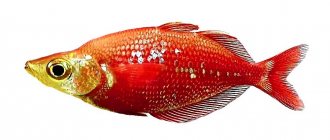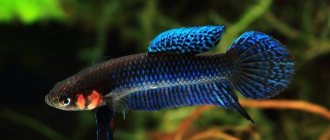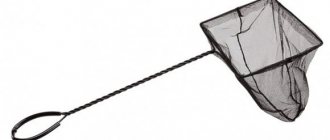Many people prefer to keep fish as pets and study the optimal diet for them, feeding regimes, etc. But what to do when you go on vacation, to the country, or on another long trip, and you don’t trust your neighbors and friends to feed your beloved pets? For such purposes, developers came up with automatic feeders programmed to dispense feed at a certain period of time.
In order to facilitate the selection of these devices, we have created a rating of the TOP 5 best automatic fish feeders: the pros and cons, characteristics, reviews, as well as the features of each model can be found in the article below.
Why do you need a fish feeder in an aquarium?
A fish feeder for an aquarium is a small and practical plastic device into which the food mixture is poured. The product allows you to accustom the inhabitants of the aquarium to adhere to the diet. This has a positive effect on the health of the fish and allows them to live longer.
Other advantages of aquarium feeders:
- the food does not scatter throughout the aquarium and does not pollute the water, so it does not have to be changed often;
- ensures uniform absorption of food by fish;
- accustoms the inhabitants of the home pond to receiving food in the same place;
- using a feeder, it is easier for the owner to give live food;
- food residues will not settle to the bottom and in the corners, where they deteriorate and release elements unsafe for fish into the water.
A fish feeder is not a mandatory accessory for an aquarium, but since it greatly simplifies the conditions for keeping waterfowl, many owners purchase this accessory to equip the tank.
General description of the device
Today, in pet stores, an automatic aquarium feeder is in great demand - a compact device that is autonomously capable of maintaining the functioning and life in the ecosystem.
Why do you need an automatic feeder?
This device is indispensable in the following situations:
- Absence from home – fish owners with irregular work schedules can entrust feeding their pets to automation. The device will take care of them on its own. An electronic feeder is also indispensable for those who often leave home for a long period of time, going on business trips or travel.
- Raising fry - breeding fish requires attention and responsibility from the aquarist. Feeding the brood should be done in small portions, but often. Not every owner has the opportunity to give food to teenagers every 3-4 hours, but a programmable device can handle this with ease.
- Maintaining cleanliness in the tank - due to the fact that food is supplied without excess (strictly in portions) in one place and time, the risk of contamination of the biotope is reduced. The fish get used to the regime and already gather at the feed introduction area in advance.
The automatic feeder keeps the aquarium clean.
It is recommended to test a new device before leaving the house for a long time to make sure that the system does not fail.
Advantages and disadvantages of automatic feeders
Like any technology, an electronic device does not always meet all user requirements. The functionality of the device can manifest itself in different ways during operation, and at some stage it does not exclude interference in human work.
| Advantages | Flaws |
| Systematic nutrition | Feeding only dry food |
| Portion control | The mixture may become damp, spoil and cause poisoning. |
| Serving food in one place | There is a possibility that the device will become clogged, and then the fish will remain hungry |
| Ability to program time and frequency | If the program fails, too much food may enter the aquarium and the fish will die. |
| Autonomous operation up to a month | Flakes and tablets in some models need to be crushed |
There is always a risk of the device breaking down, so if you plan to be away for a long time, it is advisable to have someone periodically visit the house and check the functioning of the device.
Types of feeders for aquarium fish
Manufacturers offer a large selection of feeders for aquarium fish. All of them are conditionally divided into two groups according to the principle of action. Let's take a closer look.
Floating
Floating feeders are simple products attached to the walls of the aquarium using suction cups. They are a fencing frame into which a cone with a mesh is inserted, and live food is placed inside.
Pros: low cost and minimal risk of breakdowns.
Of the minuses: when the water level in the aquarium drops, it can tilt on its side. However, if you install a special bracket that will move down and up when the water level changes, the problem of the feeder tilting can be eliminated.
Automatic
Automatic feeders are electronic products with automatic fish feeding mode. Such designs consist of a sealed compartment, a control unit, a mini-motor and a timer that allows you to program the feed supply for a certain time.
The feed is poured into a perforated drum. At the right time, food is supplied from it in a strictly defined portion. A specially installed plate, which reduces the volume of the drum, allows you to regulate the amount of mixture poured out.
Automatic feeders are indispensable when raising young animals, when regular feeding is required at short intervals. These devices are also convenient for owners who spend more than 10-12 hours outside the home. When the owner is absent, the inhabitants of the reservoir will receive food from an automated feeder on time.
An obvious advantage of such products is the complete automation of the fish feeding process. The downside is the high cost of feeders.
Mechanism of action of the automatic feeder
In order for the device to operate, you must do the following:
- Pour food into a special container.
- If there is a program that sets the dosage of food, then set the required amount of food.
- Run the program for 1 or 2 feedings a day.
- Set a timer.
- Attach the device to the aquarium and plug it into the network. Watch the feeder review in this video:
If the device operates on batteries, you must check their working condition before use. Most aquarists recommend using rechargeable batteries; they last longer and retain their power evenly.
It is mandatory to carry out hygienic cleaning of this device.
Rating of aquarium feeders
Aquarium feeders are made by different manufacturers. Based on reviews from owners, we have compiled a rating of the best fish feeders that have proven themselves in operation.
Top 5 best aquarium feeders:
- Juwel is a compact-sized feeder from a German manufacturer. It is equipped with an electronic timer and a special filter that prevents clogging of the water with food. The maximum feed supply is 2 times a day. Product weight – 32 g.
- Eheim is an automated feeder from a German brand that allows you to program up to 4 feedings per day. It is equipped with control buttons, an electronic display and a microfan, which prevents the feed from getting wet and sticking in the drum. The volume of the feed container is 100 g. The weight of the structure is 360 g.
- Sera is a German feeder that delivers food up to 6 times a day. Equipped with a round drum with a capacity of 80 g of feed. Automatic extension of feeding regimens for 30 days is available. Excellent for aquariums with young animals. Product weight – 505 g.
- Sititek is a feeder from a reliable Chinese manufacturer with two mounting options and feed up to 4 times a day. Flexible setting of modes keeps the feed crumbly and fresh. Among the disadvantages, one can note the heavy weight - 3050 g.
- Feed-Ex FF03 is a Russian-made feeder with feed supply up to 4 times a day. Transparent food container. Suitable for feeding different types of fish and young animals. Structure weight – 400 g.
The best budget models
Inexpensive automatic feeders have the minimum functionality that is necessary to ensure that the pets are always fed in the absence of the breeder.
Homefish AF-101
An easy-to-maintain, programmed device that attaches to the glass of the aquarium and can force-feed the fish every 12 and 24 hours. Features of the model include the presence of two replaceable hoppers of different volumes: 50 and 100 ml.
Advantages:
- simple controls;
- feeds exactly on time.
This model has two replaceable hoppers of different volumes: 50 and 100 ml
Flaws:
- rough dosing;
- works better with granules;
- It is difficult to remove the hopper to fill the mixture.
Resun AF-01
A small automatic feeder for installation on the wall or on the lid of the aquarium. Supplies power in the amount set by the user automatically - hourly interval 12/24 hours - and forcibly.
Advantages:
- one button control;
- miniature size.
Flaws:
- works better with medium fraction granules.
Small automatic feeder for installation on the wall or on the lid of the aquarium
Any automatic feeder is designed not only for an aquarium with fish; the device is also suitable for feeding other underwater animals - turtles, frogs, newts.
Basic criteria for choosing a feeder
When choosing a fish feeder for your aquarium, there are several important criteria to consider.
Main selection criteria:
- Simplicity and ease of installation.
- High quality material.
- Available operating modes, frequency of feeding fish and dosage of portions, taking into account the type of living creatures living in the aquarium.
- Waterproofness of the product. The food in the drum should not get wet or stick together.
- Volume of the feed container.
Also pay attention to the power source of the automatic feeder - batteries or mains operation. If you choose the second option, check the length of the cord so that you can freely connect the device to the outlet without using an extension cord.
The best automatic feeder for an average price – Feed-Ex FF03
Feed-Ex has been supplying certified automatic animal feeders to the Russian market for more than 10 years. The FF03 model is distinguished by rich functionality that is sometimes superior to expensive devices.
The automatic feeder works in real time and has:
- several feeding programs - constant, programmable by day from 1 to 99, forced (does not affect or cancel the settings for the subsequent introduction of the mixture);
- two options for dosing portions - from 1 to 9 in increments of 0.75 cm3 and without limiter 1.5 cm3;
- sound notification when the feeding cycle ends;
- Possibility of connecting a compressor.
The model is rich in functionality
The model is universal and can be installed on the lid or wall of the aquarium.
The LCD display will always inform the user about the configured feeding schedule - programmed days, current feedings.
How to make an aquarium feeder with your own hands
Some owners make their own fish feeders. As a rule, these ordinary floating structures cost a penny.
You can use polystyrene foam to make a fish feeder. A frame 1.5 cm thick is cut out of this material. The homemade design does its job well, but has a short service life. Polystyrene foam is prone to absorbing dirt and quickly loses its aesthetic qualities.
To create an aquarium feeder, you can also use a rubber tube with a cross-section of 1 cm, making it into a ring with well-fixed ends so that when immersed in water, moisture does not get into the cavity of the tube and cause the product to sink. If everything is done efficiently, the rubber feeder will float well on the water and will last a long time. In addition, this material is quite resistant to mechanical damage.
From a bottle and a smartphone
There is another way to make your own fish feeder - this is to take an empty plastic bottle and an ordinary smartphone that no one uses. The following is done:
- the bottle is cut in half - its upper part with the cap remains;
- the lid must be screwed to the neck, but not all the way, so that a small gap remains;
- food is poured into the bottle itself (if it starts to ooze through the gap in the cork, it’s not a problem, this is only at first);
- A smartphone with a pre-installed “vibrate alert” mode is placed directly into the food;
- the bottle is firmly fixed above the aquarium;
- When a call comes to this smartphone, food will flow through the gap in the neck under the influence of vibrations.
This method may look very funny, however, it works, and the owners can independently dose the food supply to the fish while being far from home.
As you can see, leaving an aquarium with fish for several days is not a problem at all. For savvy owners, you can always find a way to make a simple feeder that will last exactly as long as needed, without requiring any expense. For those who are used to trusting professionals, there is always an excellent option that is affordable in any pet store.
How to install a feeder in an aquarium
It should be comfortable and safe for the fish to get food from the installed feeder, so the owner needs to think about which place will be optimal for fixing the product.
The feeder should be installed away from filtration and aeration systems. The flow of water can wash away food and prevent the fish from eating properly.
Also, do not install the feeder next to heating appliances. It is better to choose the most distant corner from all aquarium equipment systems.
Sketch
Flash the controller with a sketch via Arduino IDE.
fish-fider.ino // library for working with I²C #include // library for working with a real-time clock #include "TroykaRTC.h" // library for working with servos #include // library for working with a display #include // library for working with buttons #include “TroykaButton.h” // pin with a servo drive #define SERVO_PIN 11 // pins to which the buttons are connected #define BUTTON_PIN_1 0 #define BUTTON_PIN_2 1 #define BUTTON_PIN_3 4 #define BUTTON_PIN_4 5 // blocking period for turning on food supply in ms #define TIME_BLOCK 60000 // create an object for working with the real-time clock RTC clock; // create an object to control the servo drive Servo myservo; // create an object of the QuadDisplay class and pass the pin number to CS QuadDisplay qd(10); // create an object to work with the button TroykaButton button1(BUTTON_PIN_1); TroykaButton button2(BUTTON_PIN_2); TroykaButton button3(BUTTON_PIN_3); TroykaButton button4(BUTTON_PIN_4); // variables for storing feeding time // default feeding time is “12:30” int hourAlarm = 12; int minuteAlarm = 30; // feeder state (current time / setting feeding time) bool state = true; // variable to store the current time unsigned long ms = ; void setup() { Serial.begin(9600); // initializing the display qd.begin(); // initializing the clock clock.begin(); // method for setting the time and date manually in the module // clock.set(10,25,45,27,07,2005,THURSDAY); // method for setting the time and date automatically during compilation clock.set(__TIMESTAMP__); // initialization of buttons button1.begin(); button2.begin(); button3.begin(); button4.begin(); // remember the current time ms = millis(); } void loop() { // reading data from buttons button1.read(); button2.read(); button3.read(); button4.read(); // request data from the clock clock.read(); // read the hours and minutes into variables int hour = clock.getHour(); int minute = clock.getMinute(); // if button “1” is held down for a long time if (button1.isHold()) { // change the state of the feeder state = !state; // depending on the current state of the feeder if (!state) { qd.displayDigits(QD_F, QD_O, QD_O, QD_d); } else { qd.displayDigits(QD_t, QD_I, QD_S, QD_H); } // wait a couple of seconds delay(2000); } // depending on the current operating mode of the feeder // “current time / feeding time” // if the mode is “current time” if (state) { // depending on the state of the buttons // increase / decrease the hours and minutes if (button1 .justReleased()) { Serial.println("1"); clock.setHour(hour + 1); } else if (button2.justReleased()) { Serial.println("2"); clock.setHour(hour - 1); } else if (button3.justReleased()) { Serial.println("3"); clock.setMinute(minute - 1); } else if (button4.justReleased()) { Serial.println("4"); clock.setMinute(minute + 1); } // display the time qd.displayScore(hour, minute, true); } else { // if the mode is “feeding time” // depending on the state of the buttons // increase / decrease the hours and minutes if (button1.justReleased()) { Serial.println(“5”); hourAlarm++; } else if (button2.justReleased()) { Serial.println("6"); hourAlarm—; } else if (button3.justReleased()) { Serial.println("7"); minuteAlarm—; } else if (button4.justReleased()) { Serial.println("8"); minuteAlarm++; } parsingFoodTime(); // display feeding time qd.displayScore(hourAlarm, minuteAlarm); } // if it's time to feed if (hour == hourAlarm && minute == minuteAlarm && millis() - ms > TIME_BLOCK) { Serial.println("Go Feed"); // enable food feed goFeed(); // remember the current time ms = millis(); } } // function for turning on the servo drive void goFeed() { // connect the servo drive myservo.attach(SERVO_PIN); for (int i = ; i 10; i++){ myservo.write(50); delay(200); myservo.write(80); delay(200); } } // time parsing function void parsingFoodTime() { if (hourAlarm > 23) { hourAlarm = ; } else if (hourAlarm) { hourAlarm = 23; } if (minuteAlarm > 59) { minuteAlarm = ; } else if (minuteAlarm) { minuteAlarm = 59; } }
How to use it correctly
To properly use the aquarium fish feeder, it is recommended that you read the instructions for use.
Rules for using the feeder:
- The new automated product should be tested outside the aquarium for several days. If no malfunctions are detected, you can install the device in water for feeding fish.
- Programming the feeder is carried out according to the instructions included with the product.
- To prevent sticking and the formation of lumps of feed in the drum of the structure, you can connect a compressor to the feeder. It will blow air over the food supply, preventing the granules from sticking together.
- The feeder should be periodically removed from the aquarium and cleaned of food debris, algae and other contaminants. This will eliminate the risk of mold formation and extend the life of the device.
Each automatic feeder comes with instructions that describe in detail the mounting methods and operating conditions of the product. Be sure to review this information.
Best premium option – Eheim TWINfeeder
The German company Eheim, which later became an association, has been producing equipment for aquariums and ponds for more than half a century. Among the range of automatic feeders produced under this brand, the TWINfeeder model is popular. Featuring a large LCD display, this device has two separate dry food bins. Each compartment has its own operating algorithm - forced and automatic (from 1 to 3 times a day), the supplied volume is approximately a quarter of a teaspoon of the mixture. This portion is given for one rotation of the auger out of nine available for one feeding.
Features of the model include the ability to program one fasting day in the weekly diet of animals.
Advantages:
- simultaneous feeding of fish that live in the upper and lower water horizons and feed differently;
- autonomous programmable operation of bunkers.
Flaws:
- the model does not distinguish between days of the week and simply alternates established operations;
- Large tablets block the operation of the auger;
- Serving sizes may vary.
This model has autonomous programmable operation of hoppers











